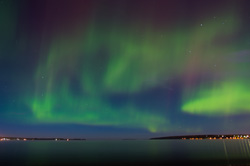The Science Behind Those Eye-Popping Northern Lights

Sarah Bird/Michigan Technological University<br> <br>Aurora borealis above Keweenaw Bay, near Baraga, Michigan, on Sept. 30, 2012.<br>
An aurora borealis (aurora australis in the Southern Hemisphere) is precipitated by explosions on the surface of the sun, sometimes starting as solar flares, said Robert Nemiroff, an astrophysicist at Michigan Technological University and coauthor of NASA’s Astronomy Picture of the Day website.
These flares release a burst of charged particles, or plasma, into the solar system. When they come our way, they whack into the Earth’s magnetosphere, which is made up of its own stream of charged particles. That collision causes particles to break free of the magnetosphere and cascade toward the Earth’s magnetic field lines, usually traveling toward the poles.
“The aurorae happen when these high-energy particles bap into atoms and molecules in the Earth’s atmosphere, typically oxygen,” Nemiroff said. Light is emitted as part of the reaction.
Those particles can also wreak havoc. “The plasma cloud can cause the Earth’s magnetic field to fluctuate,” Nemiroff said. “At worst, that can knock out satellites and even power grids.”
Aurorae can happen anytime, but it’s no surprise they are happening now.
“We are nearing the solar maximum, which is when the sun is at its most active,” he said. Solar maximums come around every 11 years, but no one knows why.
“You can have solar flares and aurorae during the solar minimum, but we get more now because the sun’s magnetic field is tangled up and poking through the surface, releasing plasma,” said Nemiroff.
Robert Nemiroff, nemiroff@mtu.edu, 906-487-2198
Marcia Goodrich, mtunews@mtu.edu, 906-487-2343
Media Contact
More Information:
http://www.mtu.eduAll latest news from the category: Physics and Astronomy
This area deals with the fundamental laws and building blocks of nature and how they interact, the properties and the behavior of matter, and research into space and time and their structures.
innovations-report provides in-depth reports and articles on subjects such as astrophysics, laser technologies, nuclear, quantum, particle and solid-state physics, nanotechnologies, planetary research and findings (Mars, Venus) and developments related to the Hubble Telescope.
Newest articles

A universal framework for spatial biology
SpatialData is a freely accessible tool to unify and integrate data from different omics technologies accounting for spatial information, which can provide holistic insights into health and disease. Biological processes…

How complex biological processes arise
A $20 million grant from the U.S. National Science Foundation (NSF) will support the establishment and operation of the National Synthesis Center for Emergence in the Molecular and Cellular Sciences (NCEMS) at…

Airborne single-photon lidar system achieves high-resolution 3D imaging
Compact, low-power system opens doors for photon-efficient drone and satellite-based environmental monitoring and mapping. Researchers have developed a compact and lightweight single-photon airborne lidar system that can acquire high-resolution 3D…





















